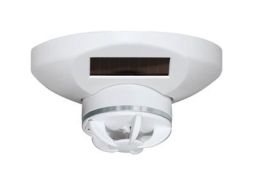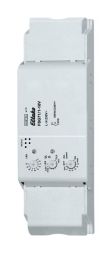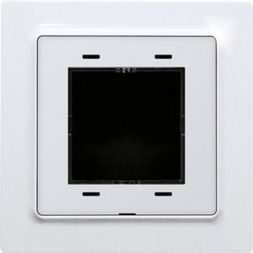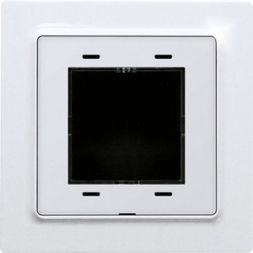Switching actuator for shading elements and roller shutters with 2 channels for two 230V motors. 2+2 normally open contacts 4A/250V AC, not potential-free. Encrypted radio, bidirectional radio and repeater function can be switched on. Standby loss only 0.8 watts. Installation in the 230V mains connection cable, for example in false ceilings and lights. 166mm long, 46mm wide and 31mm deep. With cable strain relief. Contact switching in zero crossing to protect the contacts and motors. One motor is connected to 1, 2 and N, a second motor if necessary to 3, 4 and N. If the supply voltage fails, the switch is switched off in a defined manner. The buttons can be programmed either as direction buttons or as universal buttons: Local control with universal button: With each pulse, the switch position changes in the sequence Up, Stop, Down, Stop. Local control with direction button: With a key pulse at the top, the switch position Up is specifically activated. With a key pulse at the bottom, however, the switch position Down is specifically activated. A further pulse from one of the two buttons interrupts the process immediately. Central control, dynamic without priority: With a control signal from a button taught in as a central control button without priority, the switch position Up, up or Down, down is specifically activated. Without priority because this function can be overridden by other control signals. Central control, dynamic with priority: With a control signal of at least 2 seconds from a button taught in as a central control button with priority, the switch positions Up, up and Down, down are specifically activated. With priority because these control signals cannot be overridden by other control signals until the central command is canceled again by an Up or Down key pulse from the central control button. With a control signal, e.g. from an FSM61 taught in as a central control button with priority, the switch position Up or Down and the priority are specifically activated. With priority because these control signals cannot be overridden by other control signals until the central command is canceled again by the end of the control signal. Shading scene control: Up to 4 previously stored down times can be called up with a control signal from a button with a double rocker that has been taught in as a scene button or automatically by an additionally taught-in wireless outdoor brightness sensor. When controlled via the GFVS software, travel commands for up and down can be started with the exact travel time. Since the actuator reports back exactly the travel time after each activity, even when travel is triggered by a button, the position of the shading is always displayed correctly in the GFVS software. When the upper and lower end positions are reached, the position is automatically synchronized. Function rotary switch at the bottom. The LED under the upper rotary switch accompanies the learning process in accordance with the operating instructions and indicates control commands during operation by flashing briefly.
| Property | Value |
| Number of relays: | 2 |
| Mounting type: | other |
| Radio frequency: | 868 MHz |
| Number of commands: | 32 |
| Color: | white |
| Material: | plastic |
| Halogen-free: | yes |
| Surface: | other |
| Mounting type: | other |
| Material quality: | Thermoplastic |
| Surface finish: | matt |
| Suitable for protection class (IP): | IP20 |
| Suitable for dimmer: | no |
| Suitable for pulse pushers: | yes |
| Suitable for roller shutter switches: | yes |
| Suitable for switches: | yes |
| Rolling code system: | yes |
| In the housing: | yes |
| In the tube base housing: | no |
| As a module/circuit board: | no |
| Touch operation: | yes |
| Switching operation: | yes |
| With radio hand transmitter: | no |
| With radio coding device: | no |
| With radio button: | no |
| Suitable for blind switches: | yes |
| Suitable for blind/roller shutter switches: | yes |
| Transparent: | no |







